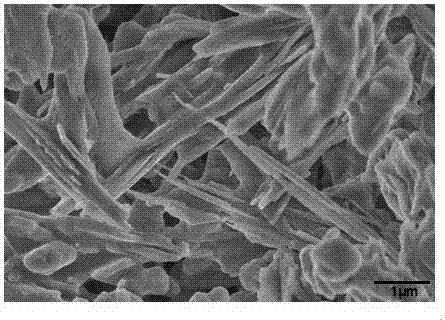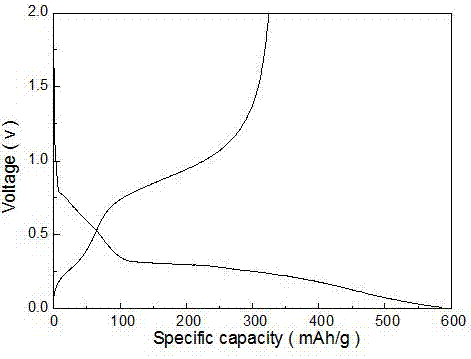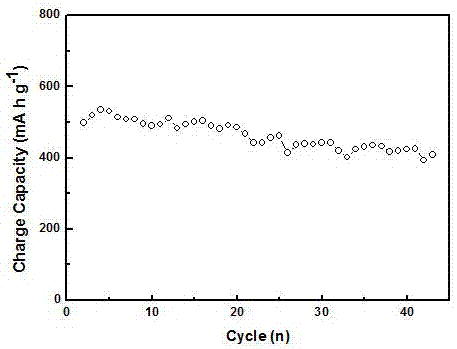Caron-coated stannous oxide compound and preparation method and application thereof
A stannous oxide and carbon coating technology, applied in electrochemical generators, electrical components, battery electrodes, etc., can solve problems such as large volume change and poor cycle performance
- Summary
- Abstract
- Description
- Claims
- Application Information
AI Technical Summary
Problems solved by technology
Method used
Image
Examples
Embodiment 1
[0026] Example 1 Carbon-coated stannous oxide composite material
[0027] Dissolve 0.81g of Tris in 1L of water, stir, and prepare a buffer solution with pH=7.5; measure 20mL of the prepared buffer solution with a graduated cylinder, add 30mg of stannous oxide (SnO) into the buffer solution, Stir for 30 minutes to obtain a black turbid solution; add 10 mg of dopamine, and continue stirring for 47 hours; wash the obtained black liquid with distilled water and ethanol several times, centrifuge, and then put it in a vacuum oven at 60°C for drying; finally dry the black The material was calcined at 400°C for 2 hours under a nitrogen atmosphere, and the heating rate of the calcination was 4°C / min to obtain a carbon-coated stannous oxide (tin monoxide) composite material.
Embodiment 2
[0028] Example 2 Carbon-coated stannous oxide composite material
[0029] Dissolve 1.6g of Tris in 1L of water, stir, and prepare a buffer solution with pH=9.5; measure 80mL of the prepared buffer solution with a graduated cylinder, add 30mg of stannous oxide (SnO) into the buffer solution, Stir for 25 minutes to obtain a black turbid solution; add 20 mg of dopamine, and continue stirring for 47 hours; wash the obtained black liquid with distilled water and ethanol several times, centrifuge, and then put it in a vacuum oven at 60 ° C for drying; finally dry the black The material was calcined at 450°C for 2 hours under a nitrogen atmosphere, and the heating rate of the calcination was 4°C / min to obtain a carbon-coated stannous oxide (tin monoxide) composite material.
Embodiment 3
[0030] Example 3 Carbon-coated stannous oxide composite material
[0031] Dissolve 1.21g of Tris in 1L of water, stir, and prepare a buffer solution with pH=8.5; measure 50mL of the prepared buffer solution with a graduated cylinder, add 30mg of stannous oxide (SnO) to the buffer solution, Stir for 30 minutes to obtain a black turbid solution; add 30 mg of dopamine, and continue to stir for 48 hours; wash the obtained black liquid with distilled water and ethanol several times, centrifuge, and then put it in a vacuum oven at 60 ° C for drying; finally dry the black The material was calcined at 400°C for 2 hours under a nitrogen atmosphere, and the heating rate of the calcination was 4°C / min to obtain a carbon-coated stannous oxide (tin monoxide) composite material.
PUM
 Login to View More
Login to View More Abstract
Description
Claims
Application Information
 Login to View More
Login to View More - R&D
- Intellectual Property
- Life Sciences
- Materials
- Tech Scout
- Unparalleled Data Quality
- Higher Quality Content
- 60% Fewer Hallucinations
Browse by: Latest US Patents, China's latest patents, Technical Efficacy Thesaurus, Application Domain, Technology Topic, Popular Technical Reports.
© 2025 PatSnap. All rights reserved.Legal|Privacy policy|Modern Slavery Act Transparency Statement|Sitemap|About US| Contact US: help@patsnap.com



